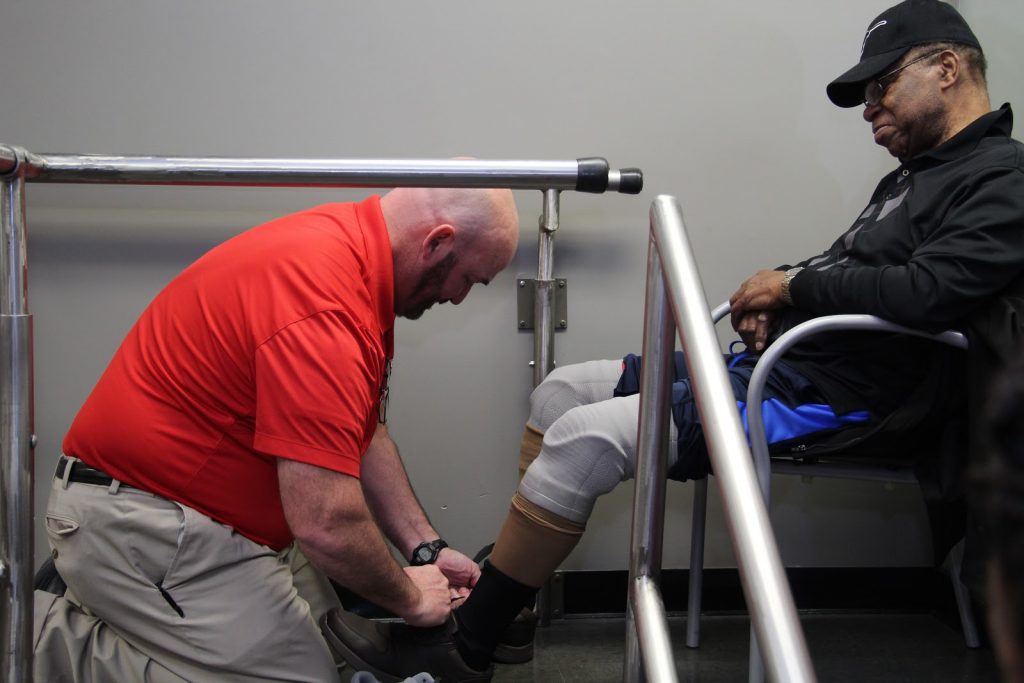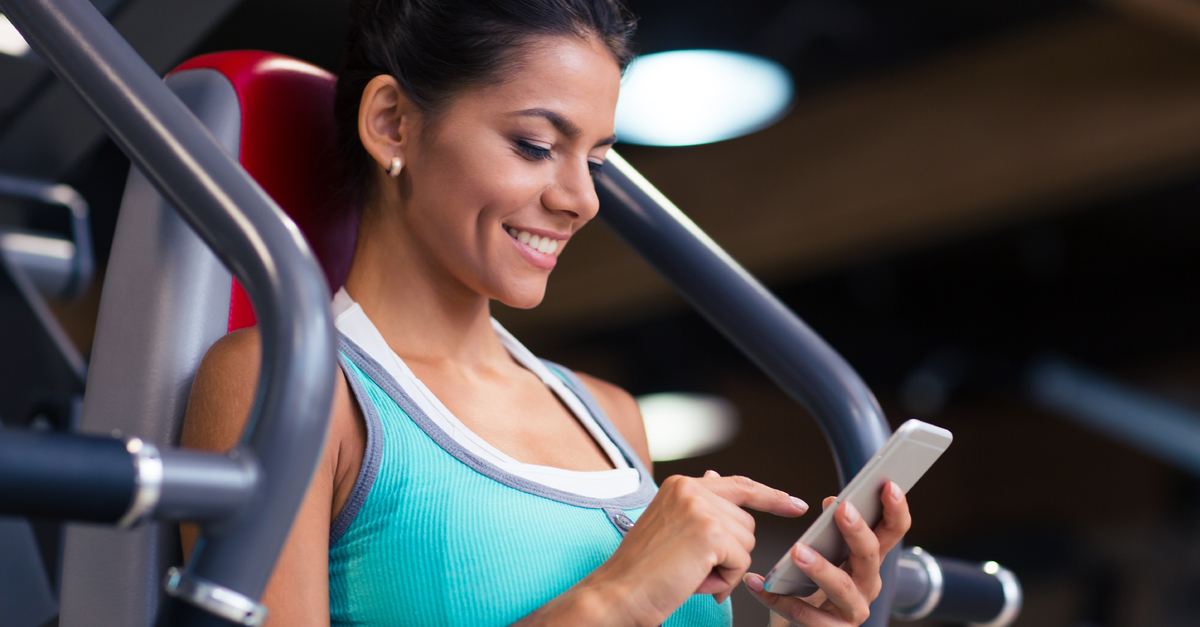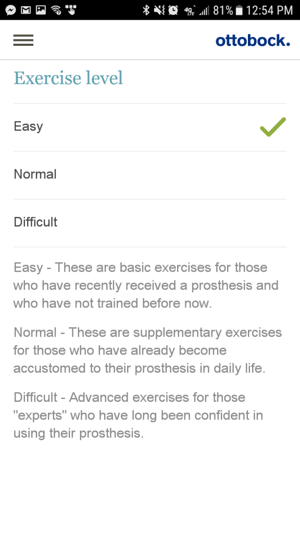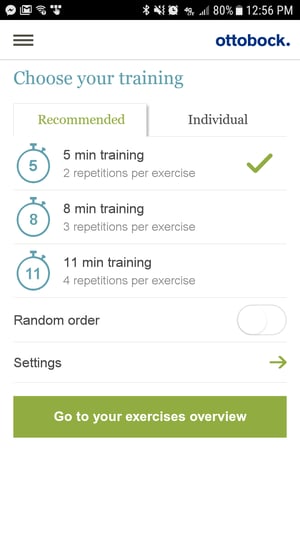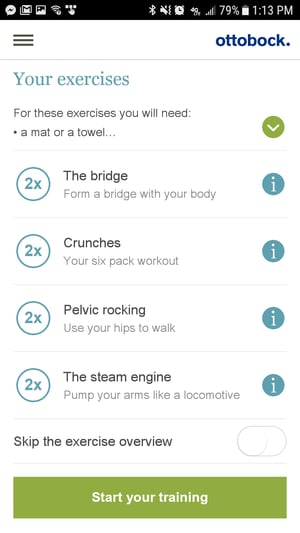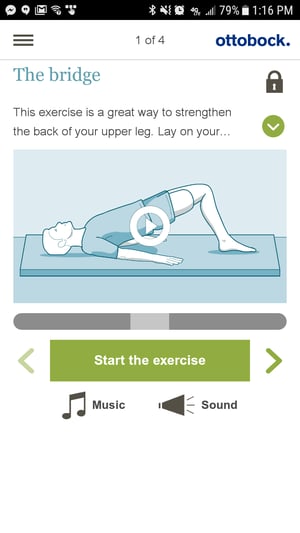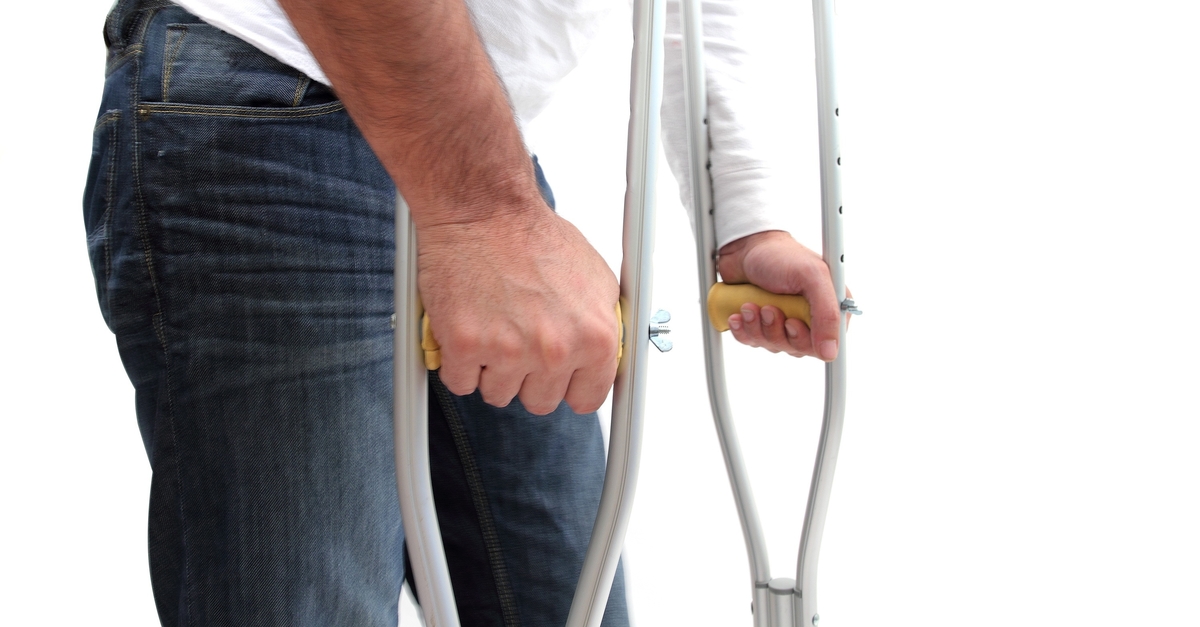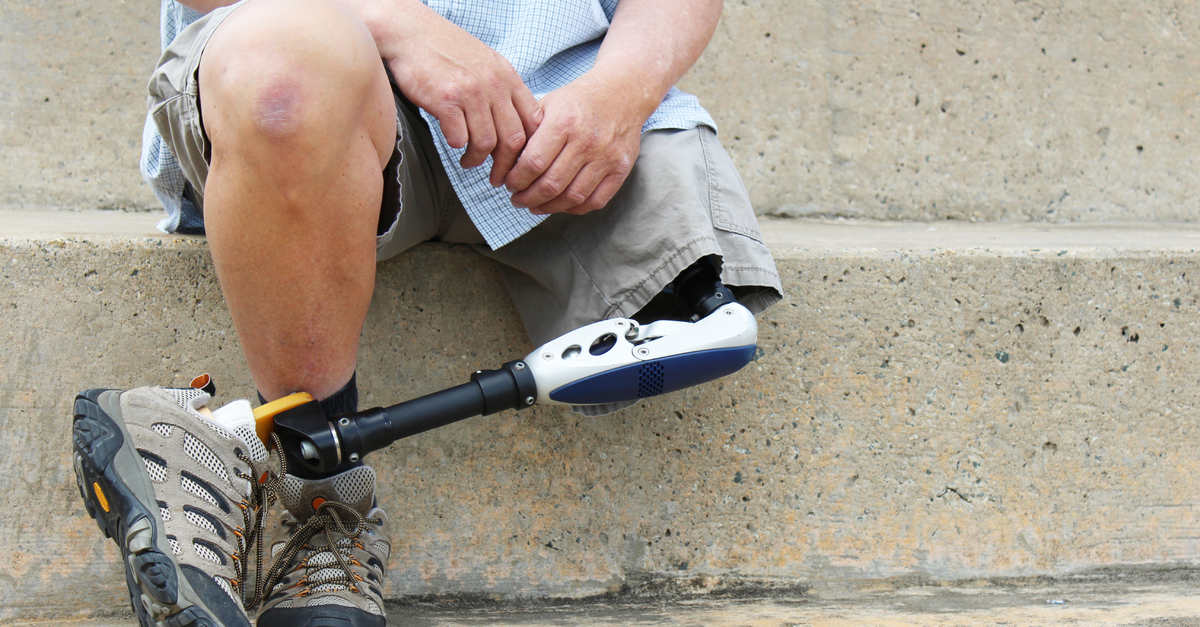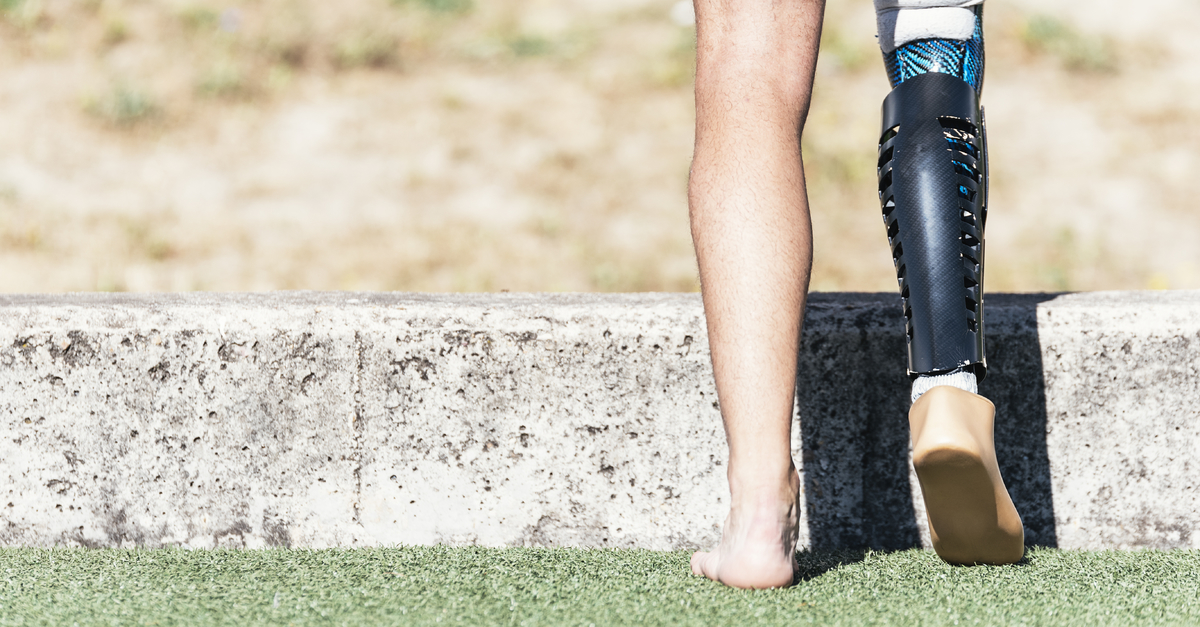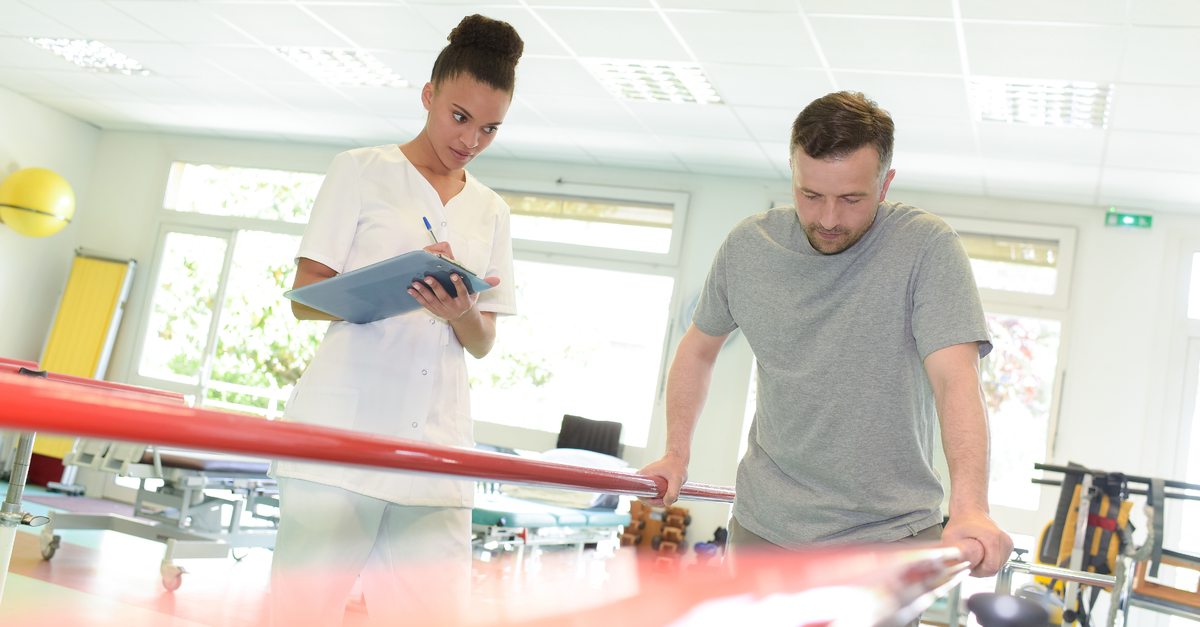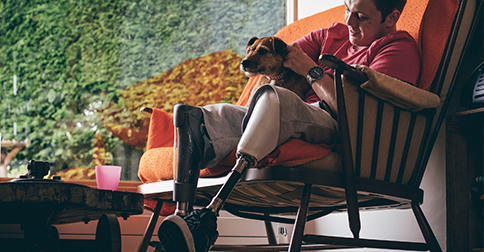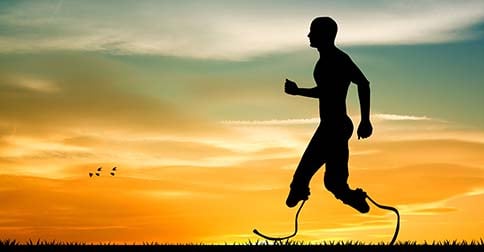Those who have experienced limb loss have a lot to learn when it comes to living a full, functional life. One of the things that many amputees have to adjust to is sock management - i.e. using socks to control and adjust the fit of their device for maximum comfort and function.
As you’ll see, sock management isn’t always intuitive. But it’s key to being as comfortable as possible with a prosthetic device.
Why Is Sock Management Important?
When people wear below the knee prostheses, they wear socks of different thicknesses, which we call plys. For one recent patient of ours, for example, we gave him 1-ply, 3-ply, and 5-ply socks. A 5-ply sock is five times thicker than a 1-ply sock. So, if you’re wearing five 1-ply socks, it’s the same as wearing one 5-ply sock.
When a patient with a below the knee prosthesis takes the leg off at night, and when they lay in their bed in a horizontal position, their body fluid goes all throughout their body and their legs swell up a little bit. When they put their weight on the prosthesis, they’re pushing body fluid up and out of the limb, which means the residual limb shrinks throughout the day.
How Sock Management Can Be Counter-Intuitive
How we adjust socks to fit our limbs and prostheses isn’t as straightforward as you’d think.
When something feels tighter, we normally think we should remove a layer. If you were wearing two socks in your shoes, for example, and your shoes felt tight, common sense would tell you to take off a layer.
But with limb loss, it’s different. Since that residual limb is smaller during the day, it’s pressing deeper into the socket as pressure is applied to it. That is what makes the socket feel tighter.
So, the solution is to add another layer to provide a buffer, which is done by adding another sock or going up to a higher ply sock.
It’s counter-intuitive, but it’s a very important piece of information for any person with limb loss.
Practice Makes Perfect
Through practice, you’ll learn how to listen to your body and adjust as needed. You’ll become more familiar with the patterns of your body and how your prosthesis fits throughout the day, and you’ll get better at sock management to make sure you’re comfortable all day long.
We recently had a patient named Mr. Nall. Mr. Nall is a double amputee with two below the knee prostheses. One of the things he has learned is how to manage fit through his socks. We gave him 1, 3, and 5-ply socks and taught him how to listen to his body. As a result, he’s walking better and experiencing more comfort, too.
Now, Mr. Nall can go to his beloved Miles College and watch the Golden Bears play while walking up and down the stands in comfort - thanks to sock management.
At BioTech, we help our patients learn sock management as a part of our service to them as valued patients. If you have a question about sock management, or anything to do with getting a prosthetic device, contact us - we’d love to help.
Living with limb loss can be challenging, but in today’s world, there’s a wealth of resources to make life easier and more productive for amputees.
This includes technology that helps you make the most of your prosthesis and create possibilities. Ottobock, one of the world’s leading manufacturers of prostheses, designed its Fitness for Amputees app (available in iTunes or Google Play) for people who want to keep in shape with a prosthetic device.
We downloaded the fitness app and decided to create a review of the app for our patients and others who are dealing with limb loss and want help staying in peak condition.
Overview
Fitness for Amputees was developed by therapists working with Ottobock and is designed primarily for lower limb amputees. The app is cleanly designed and easy to navigate, and consists of three modules:
- Strength and endurance
- Coordination and balance
- Stretch and relax
Each module contains exercises that were designed by physical therapists to develop each of those areas. And each module can be scaled up or down in difficulty.
When you select an area to work on, the app will take you through a series of exercises that range in duration and intensity. You can use their recommended settings or create your own.
The result is a fairly customizable program tailored to your personal preferences.
Key Features
The Fitness for Amputees app has several key features, including:
- 3 different types of exercises
- Customizable, individual programs
- User data that tracks statistics
- Four exercises per exercise area
As far as the exercises go, each of them is recommended and a good thing to do, but there’s not a lot of variety because each area only has four. However, it’s a great place to start, and for many users, four is enough to create a solid program.
User Interface
The user interface is clean, easy to navigate, and easy to use. The text is easy to read, and the app does a good job of explaining what to do, with sample videos for each exercise (plus music to go along with the timer):
Overall, the layout is simple yet elegant and user-friendly as well.
Should You Use It?
There are a few minor things we’d recommend to improve it, namely more diversity in exercises and just more exercises period, but overall, Ottobock’s Fitness for Amputees app is a winner. If you’re looking to build up strength, increase balance, or just stretch your muscles, the app is an easy way to go about it and is a terrific intro into more complicated or advanced physical therapy regimens you may participate in down the road.
Download the Fitness for Amputees App Here
BioTech Limb and Brace makes prosthetic and orthotic devices that take advantage of cutting-edge technology to put smiles on peoples’ faces. Learn more about our personable approach and how we help patients and their families thrive.
Maintaining a proper diet is important for everyone, but for those who’ve experienced limb loss, it’s truly life changing. Not only does a healthy diet make gait training and other challenges easier, but eating poorly can create life-threatening problems. However, staying healthy is easier said than done, and finding the right foods for the body can be difficult. Let’s discuss some recommended methods of keeping a healthy diet after limb loss.
Food
First and foremost, stay away from fast and unhealthy foods. While this sounds like obvious advice, it’s a challenge for many of us! Next, add some variety to your plate - and make it a balanced meal. Make it a goal for half of your plate to be fruits and vegetables, a quarter protein, and a quarter starches. Remember, protein doesn’t have to be meat. Beans and lentils are among the many replacements you can use.
There are also specific foods that improve the wound-healing process. This includes protein, carbohydrates, polyunsaturated fatty acids, and certain vitamins and minerals. These allow you to receive the necessary nutrients for a much more efficient healing process.
Portions
An important truth to face after limb loss is that your calorie intake will change. This means that your portions will need to be smaller, and snacking will have to be reduced. There will also need to be a focus on reducing the amount of food eaten due to stress, boredom, anger, and other stimuli. Eating slowly gives your body time to tell you it’s full, so take your time and enjoy your meal. It’s better to be comfortably full then overly stuffed.
Planning
Preparing healthy meals is very important for continuing positive progress with your diet. Not having to make a meal every time you’re hungry eliminates one of the biggest obstacles of improved eating! Whenever you cook, make more than you need and freeze some for future dinners. We all get tired after work, and having an easy option ready to go gets rid of the unhealthy temptation to order fast food.
BioTech Can Help
Our years of experience have allowed us to see what works best for those with limb loss. We are experts in everything from diet to exercise, and much more! Make sure you’re getting the most out of your prosthetic experience, and let the BioTech team provide the best path to a long and healthy life. Contact us today for more information.
Prosthetic devices continue to make drastic improvements with each new year, but no matter how sophisticated they become, there are still simple everyday tools that can improve inconveniences like prosthetic limb irritation and nighttime mobility. Whether they are used on the device itself or in the environment around the user, there are thousands of little life hacks to greatly improve the entire experience.
Crutches
Between long days, emergency situations, and nighttime needs, crutches are pretty important to have around. However, the crutches most of us think of are no longer the only options for those who’ve experienced limb loss. There are many more options available now, and designers and entrepreneurs have created crutches based on specific needs they have noticed. Want crutches with great hand grips? How about SideStix Crutches, which allow you to become much more active? We think they’re a great option.
Bike Hex Wrench
This tool is easy to carry and greatly improves your ability to adjust prosthetic alignment while out and about. They are very affordable, with an average price below $10, and the convenience they provide will have you wondering what you did before you got one!
Shoe Horns
Anyone with a leg prosthesis can attest to the difficulty of trying to put on a shoe. Shoe horns are great for the home, but it’s important to have them elsewhere, as well! Keep one nearby as often as possible, and avoid spending time stressing over getting your shoe on.
Handrails
Placing handrails in necessary areas throughout your house will make your everyday experience much easier, while also providing more stability for visitors! They are also a generally cheap home improvement project and can be taken as an opportunity to spruce up your home a little.
Ask BioTech for Help!
Since our founding in 2000, we’ve made it our priority to make every part of the prosthetic experience as comfortable as possible. Whether you’re seeking consultation, a better prosthesis, or you have questions about improving your daily well-being, we are ready and available to help you turn disabilities into possibilities! Contact us today for more information.
Phantom limb pain, or PLP, is a frustrating symptom of limb loss that still doesn’t have a simple solution due to its unique nature. Even though the limb is no longer there, the patient feels a painful sensation that’s been described as everything from itching to burning. The severity and length differ from patient to patient, but it remains unpleasant no matter how extreme it feels. While there isn’t one simple method of solving phantom limb pain, a combination of different treatments can dramatically reduce the symptoms.
Understanding Phantom Limb Pain
Although there is still much to be learned about PLP, the modern day consensus is that it’s created by signals from the brain and/or spinal cord. Due to this belief, many recent treatments aim to fix these signals to reduce the pain. An important thing to understand if you are experiencing phantom limb pain is that seeking treatment needs to be a priority! Many people dealing with these symptoms are afraid of telling their loved ones due to a fear that they will be deemed “crazy” or “dramatic.” However, sharing your pain and finding the solution doesn’t need to wait any longer than necessary. The earlier you get a doctor to review your symptoms, the faster the symptoms will go away.
Solutions
As we said earlier, there is no one end-all solution for phantom limb pain as this point in time - but there are multiple methods that can do wonders for your symptoms. The best option varies for each patient, but here are some of the most used methods:
- Deep brain stimulation - This technique sends electric impulses to the surface of the brain to reduce the level of pain felt by the patient. As we said earlier, the brain is viewed as a cause for PLP symptoms, so this addresses the problem “head-on.”
- Local Injection Therapy - You’ve probably heard of pain blocks for back issues and similar injuries, and this is no different. The injection will take place on the affected limb.
- Mirror Box Therapy - This is not a surgical procedure, but rather a conditioning of the mind. While participating in physical therapy, this exercise requires the patient to look in a mirror so the brain registers that there is no longer a limb where there once was.
- Nerve cuff stimulation - An impressive display of technology that sends positive signals through the nerves of the affected limbs. This actually allows the patient to be in control, as they can send a signal whenever they are feeling pain.
- Non-opiate analgesic - When the pain is unbearable, pain medications will decrease the level of discomfort that the patient feels.
BioTech Can Help!
From the pre-op consultations to the physical therapy after, BioTech has years of experience guiding our valued patients through the various trials that await them - including PLP. Not only do we understand the problems that are going to occur, but we know the proper methods to solve them. Have a question for the BioTech team or looking to upgrade your prosthetic experience? Contact us today!
Using a prosthetic device creates an unfathomable amount of new freedom for those who’ve experienced limb loss, but there are still a couple of inconveniences that come along with them. Learning methods to improve your comfort and functionality is important for improving your overall well-being. There are thousands of wonderful items out there that make the little things more convenient. Keep reading to find out a few of our favorites!
Oils
It doesn’t take much for skin to get irritated, as many prosthetic users can say. But there are many oil-based accessories to decrease the amount of irritation your skin faces on a daily basis -- all you have to do is find the best one for you! Here are some of the ones we have found most effective:
- Body Oil - Apply this to the skin at the top of your liner to reduce redness.
- Coconut Oil - This oil has garnered quite the reputation as being the ultimate fix-all, and this applies to damaged skin. Apply it at night for recovery of the skin that experiences rubbing from your prosthesis.
- Jojoba Oil - Putting this on before you go to bed will help reduce any irritation you may have.
- Silicone-based lotions - We understand that this isn’t the typical recommendation, but this particular type of lotion absorbs less than others, which gives your skin a break from the uncomfortable side effects of rubbing against a prosthesis.
Clothing
Clothing is a major part of who we are, but it can sometimes get complicated with a prosthetic limb. Shoes and pants especially face some difficult scenarios, but there are ways to prevent minor inconveniences. One that we see a lot would be sockets tearing away at pants. Ironing patches on the inside of your pants, where the rubbing occurs, can help prevent it from damaging your clothes! In regards to shoes, sandals and flats will often be a pain to walk in. However, Velcro is a great solution to combat this problem!
Ask Us Your Convenience Questions!
We’ve seen a lot of great ideas in our 17 years as a company, which gives us plenty of advice to share for those with questions. Every part of BioTech, from the building to the technology, is designed to give our patients the easiest experience possible. This includes our staff, who are knowledgeable, experienced, and have a passion for helping motivated individuals turn their disabilities into possibilities! Contact us today for more information.
Gait training is physical therapy that focuses on improving the patient’s ability to walk. It’s used to help patients recover from any injury or condition that impairs upward mobility. Understandably, this is very important to people who’ve recently received a leg prosthesis. It’s a long, difficult road to recovery, but the outcome is well worth the effort. What exactly does gait training involve? Read further for a better understanding of the recovery process!
Strength
The key to strength training is recognizing which muscles need improvement and focusing on them. Of course, since these muscles are weak starting off, it won’t feel too pleasant at the beginning. The burning in the muscles means you're getting stronger, and soon, your walking will improve more than you could imagine. Repetition is important for getting these muscles back to working condition, so stay focused on the end goal no matter how tough it feels to keep moving forward. You WILL thank yourself later.
More Advanced Exercises
Once the muscles begin to strengthen, we can focus on more individual tasks to improve mobility. Having sturdiness back in the lower body is wonderful, but there are still movements that need to be mastered. This involves more aerobic-based exercises, like treadmill training or mobility training. These can help you get accustomed to movements involved in walking, running, bike riding, and other activities with a focus on the lower body. The main focus should be on repetition and working up a sweat. Don’t worry about how fast you’re going or if you get tired easily. As long as you’re putting in effort and staying consistent, the results will show!
Contact Us for Help!
BioTech has decades of experience with both designing prosthetics and helping our patients with the journey back to an active lifestyle. Our team has the experience and passion to provide the best possible outcome for anyone who’s ready to turn their disabilities into possibilities. This is much more than a job to the BioTech team; it’s our joy and calling. Looking to take the next step towards a full recovery? Contact us today for more information!
There are few amputees who don’t struggle with body image issues after limb loss. Although many people assume women’s body image struggles are worse than men’s, this isn’t really the case; men have the same problems women have.
Even if your amputation is planned and you feel like you have mentally prepared for what’s coming, you’ll probably still get hit with body image issues. So what’s the best thing to do if this happens? How can you learn to love your body again?
Embrace Your Individuality
The first thing to know is that everyone’s path to acceptance looks different. We wish we could outline a step-by-step program that would have you loving your body in 3 weeks or less! But that’s just not reality.
Whether you’re in denial about what’s happened, or you’re just beginning to glance into the mirror for the first time, accepting your new body is going to take some time – and it won’t happen the same way for any two people.
Process Your Feelings
Others may applaud you for your bravery, especially once you begin returning to work or school. You might be tempted to “fake it” for a while – acting like you are fine with your new body, even though you aren’t.
While total transparency may not be an option for you in the workplace, you should seek out a safe space in which to express how you really feel, deep down. Maybe you feel a lot of self-loathing because of your amputation, even though you’re not to blame for it. Maybe you can’t look in the mirror without crying. Maybe you are struggling to even get through the day.
This will get easier, but in the meantime, a counselor or trusted friend can help you vent your fears, anger, and frustration in a safe way. Give yourself the resources you need to move through this process – don’t stuff your feelings away.
Give It Time
As you learn to live with limb loss, you will become accustomed to your new body shape. You’ll learn to give yourself grace as you deal with difficult, sometimes irrational, emotions. By putting words to your emotions, you will find that they become easier to handle – which means you’ll move through them at a healthier pace. Soon, you will see strength and resilience in the mirror instead of an incomplete body – and that’s when you know you’re well on your way to loving your body again after limb loss.
Happy Valentine’s Day from BioTech!
No matter where you are in your limb loss journey, BioTech is here to show you some love! Have a wonderful Valentine’s Day, and contact us for all your prosthetic and orthotic needs!
The winter months can be hard for everyone – transportation gets trickier, the sidewalks can get slippery, and if it snows, just forget about it! But when you’re new to limb loss and trying to adjust to your prosthetic device, things can be even more challenging. Check out these winter limb loss tips that will make your life easier!
Challenges Amputees Face in the Winter
Winter can pose a whole new set of challenges for people with limb loss. Newer prostheses are often mostly constructed of metals that are left exposed, and when the weather gets really cold, that chill can creep through the socket into your residual limb.
Another challenge is walking on ice. Typically, when a person walks on an icy surface, they walk almost completely flat footed to compensate for the lack of traction. But when you have a leg prosthesis, your ankle can’t always adapt that way – which means slipping is a very real possibility.
Solutions for These Issues
The best option for keeping your prosthesis and your residual limb warm this winter is insulation. If you’re not sure what that looks like or where to find it, there are all kinds of options, from sleeves to liners and more. Just make sure to bundle up, even if you’re not wearing your prosthesis – your residual limb can get very irritated and start to hurt from the cold weather.
(As a side note, it’s advised that you don’t skip wearing your device in the winter – so do your best to be consistent!)
When it comes to walking on ice, there are bionic ankles that can bend with greater acuity than ever before. But if that’s not something you’re interested in, there’s also a wide variety of shoes with exceptional traction that can help you stay upright on an icy surface.
Want More Winter Limb Loss Tips?
Here at BioTech, we’re experts on winter prosthetic technology and caring for your device. Make sure you’re comfortable and safe this season by contacting us for more information about wearing your prosthesis in the winter!
Exercise might be a bit of a challenge after limb loss, but ultimately, the choice is yours: will you let limb loss dictate your fitness routine, or will you rise to the occasion and keep your body in top condition, no matter what?
Below, we’ll talk about some ways to maintain your fitness with a prosthetic limb. Read on!
Begin at an Appropriate Level
When you think about it, exercise for someone who has all four limbs really isn’t that different than exercise for amputees. In each case, the person who is starting an exercise program needs to recognize their abilities and their obstacles, and they must start -- and continue -- exercising at the correct level for their physique. If they do too much, they risk injury; if they do too little, the program will ultimately be ineffective.
Someone who wears a prosthesis must begin their workout program at an appropriate level of challenge just like anyone else. The only difference is adapting to a mechanical device that wasn’t there before, which, admittedly, is a different sort of challenge than the kind that someone with all four limbs might face. But if it’s treated as part of the fitness routine, and the person who is exercising chooses to “get used to” the device just as they will get used to the physical demands of their exercise, they may be shocked at how much success they find.
Recognize the Benefits
Just like people without limb loss, amputees will see myriad benefits from engaging in an exercise program. Some of these benefits include:
- Improved functioning of heart, lungs, and muscles
- Better flexibility, mobility, and coordination
- Prevention of limb atrophy and muscle hypertrophy
- Stress management
- Overall sense of well-being
- Improved self-esteem
- Better sleep
Although many people with limb loss are fearful of hurting themselves, feeling uncomfortable, or being scrutinized while exercising in public, the fact is that the benefits far outweigh the possible risks.
Yes, exercise for amputees can be very demanding -- but with a little determination and the help of a fitness professional, anyone can reap the rewards of better physical, emotional, and mental health!
Become Empowered with BioTech!
Exercise for amputees isn’t just about physical fitness or mental health. It’s about setting a challenge for yourself and overcoming it. It’s about finding your inner strength -- that deep-rooted power you may not even know is there. And once you’ve discovered it, you’ll realize the only limits you really have are the ones you place on yourself.
BioTech can help you discover your inner power! Contact us today for help with prosthetic limbs, expedited fittings, and expert advice. We are here to help!
